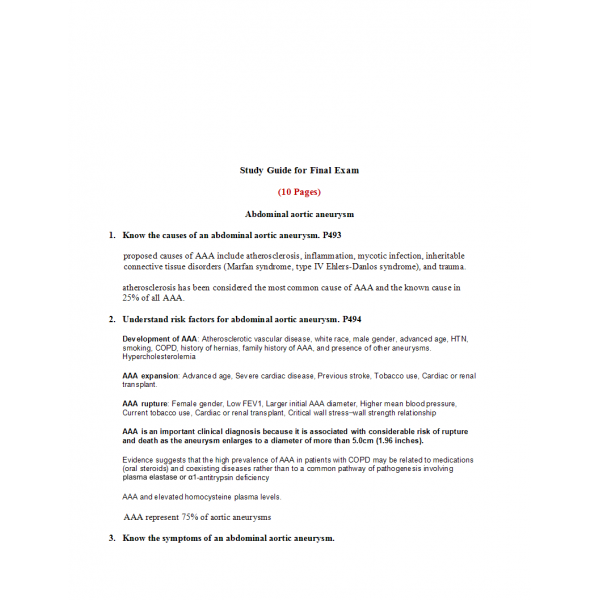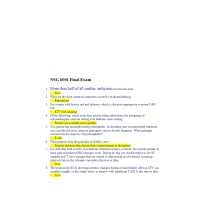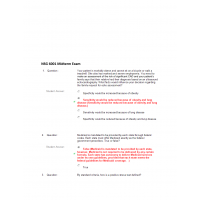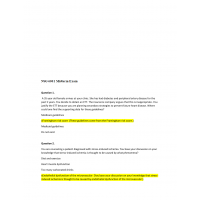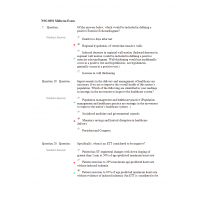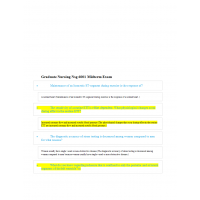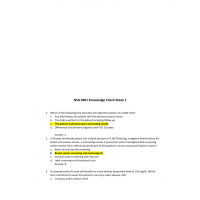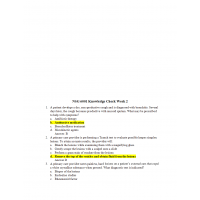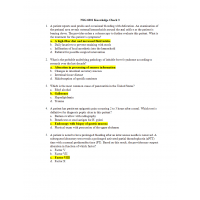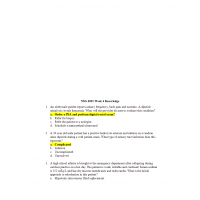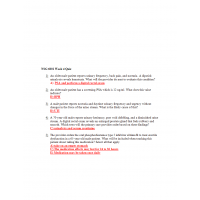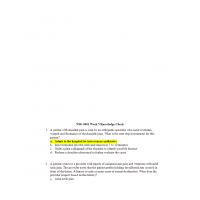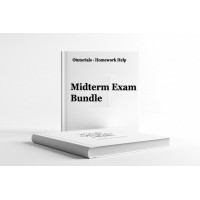NSG 6001 Final Exam Study Guide
Abdominal aortic aneurysm
- Know the causes of an abdominal aortic aneurysm. P493
- Understand risk factors for abdominal aortic aneurysm. P494
Development of AAA
AAA expansion
AAA rupture
AAA is an important clinical diagnosis because it is associated with considerable risk of rupture and death as the aneurysm enlarges to a diameter of more than 5.0cm (1.96 inches).
- Know the symptoms of an abdominal aortic aneurysm.
Symptoms:
Symptom and sign of a ruptured AAA
classic diagnostic triad of ruptured AAA is hypotension (42%), pulsatile abdominal mass (91%), and abdominal pain (58%) or back pain (70%). The triad is encountered in only 50% of patients with a ruptured AAA. Ruptured AAAs should be suspected in any patient who comes in with complaints of hypotension and atypical abdominal or back pain symptoms
- What is a Saccular Abdominal Aneurysm?
- What are the risks for abdominal aortic aneurysm?
- Diagnostic Testing for CAD
- Why is CT imaging limited in women? P492
- Can ischemic changes on an ECG during or after an ETT correlate to the effected artery or arteries?
- What diagnostic test is used for CAD? P488
Exercise Tolerance Test
Myocardial Perfusion Imaging
Cardiac Magnetic Resonance Imaging (MRI)
Exercise Echocardiography
- Understand the coronary flow related to CAD.
- What is the best reason to add a Doppler flow studies during an echocardiogram study?
- What defines a positive exercise echocardiogram?
- What changes would you see during an ETT that are highly predictive of CAD? P489
13. What is an Isometric ST-segment during exercise caused by? P488
14. Where would you measure the J point located on an ECG in relation to the QRS and ST-segment depression after an exercise stress test? P488
- Why would you order an ETT in a symptomatic woman with a normal ECG?
- What predictive value does a significant ST-segment elevation have for CAD? p488
- What physiological changes occur during effort in the routine ETT?
- What does an abnormal left ventricular ejection fraction on an echocardiogram mean for a patient during an ETT? P490
- Know the reasons for using the risk stratification according to the Farmingham risk score to justify a ETT in an asymptomatic patient.
- Heart Failure
- Where could you find supporting data for guidelines for prevention of future heart disease? P456
- What are the signs of heart failure? p541
Symptoms:
Shortness of breath (dyspnea)
Persistent coughing, bronchospasm, or wheezing-
Edema
Signs
Jugular venous distention:
Crackles, frothy or pink sputum, pleural effusions-
Third heart sound:
Fourth heart sound:
Aortic stenosis:
Mitral regurgitation:
Tricuspid regurgitation:
Hepatomegaly, right upper quadrant tenderness:
Physical Exam:
Ascites, anasarca, or edema:
Physical Exam:
Altered hemodynamics:
Tachycardia:
Displaced point of maximal impulse:
Hypotension, cool extremities:
| Institution & Term/Date | |
| Term/Date | South University |
NSG 6001 Final Exam Study Guide
- Product Code: 2019
- Availability: In Stock
-
$25.00
Related Products
NSG 6001 Final Exam 1
$45.00
NSG 6001 Midterm Exam 1
$25.00
NSG 6001 Midterm Exam 2
$25.00
NSG 6001 Midterm Exam 3
$15.00
NSG 6001 Midterm Exam Review
$25.00

